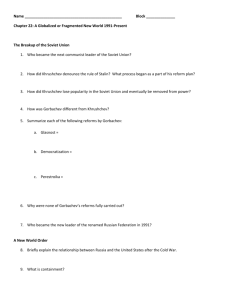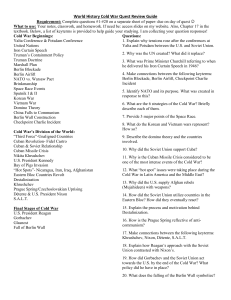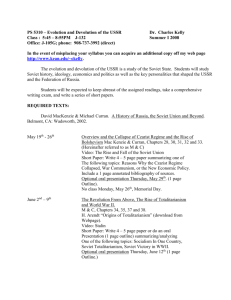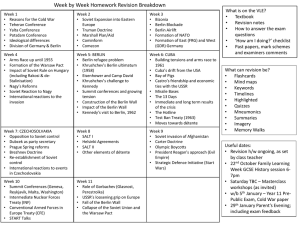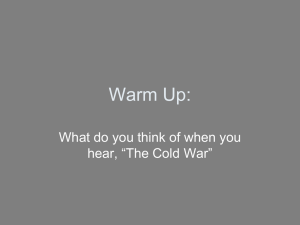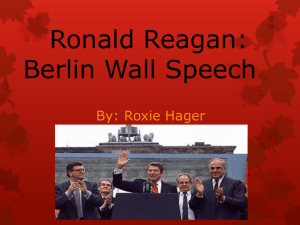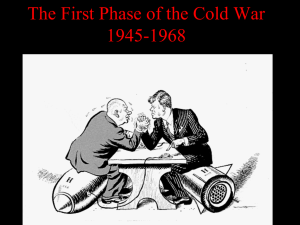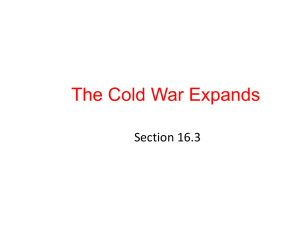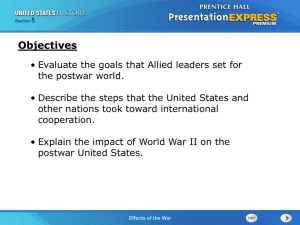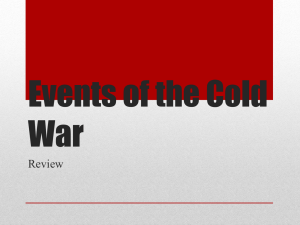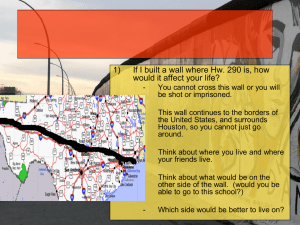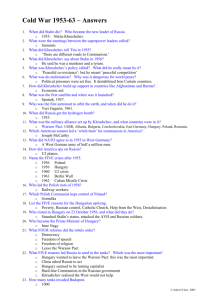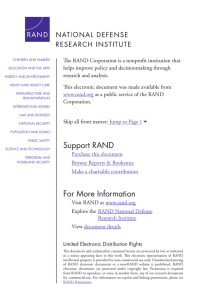AP European History - Hinsdale Central High School
advertisement
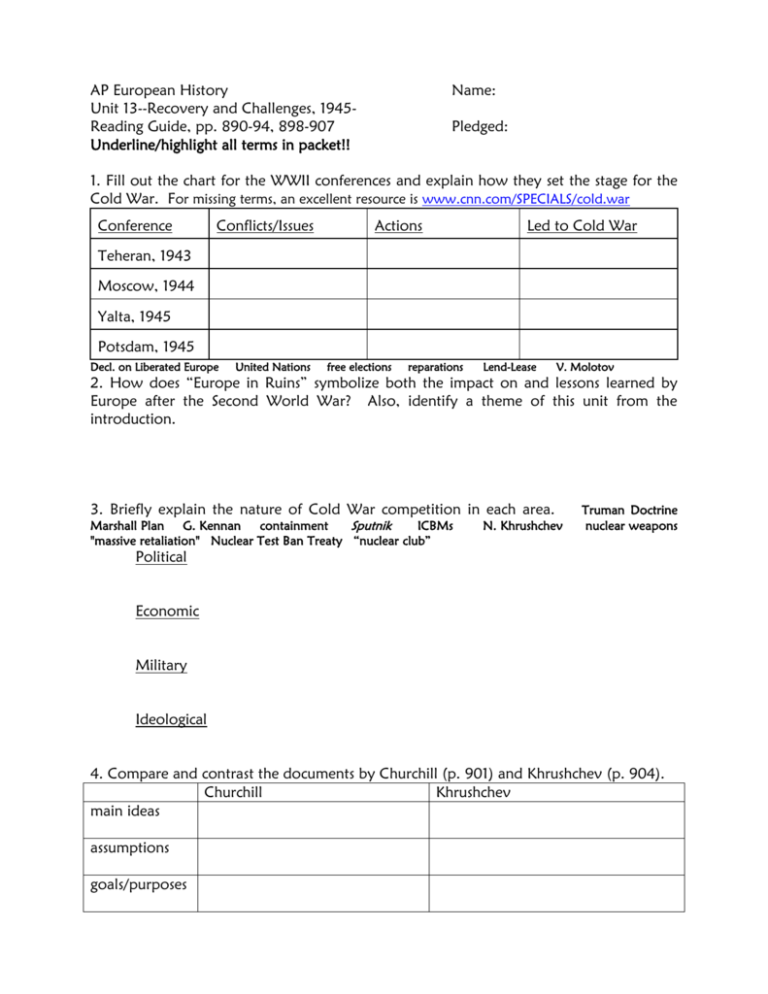
AP European History Unit 13--Recovery and Challenges, 1945Reading Guide, pp. 890-94, 898-907 Underline/highlight all terms in packet!! Name: Pledged: 1. Fill out the chart for the WWII conferences and explain how they set the stage for the Cold War. For missing terms, an excellent resource is www.cnn.com/SPECIALS/cold.war Conference Conflicts/Issues Actions Led to Cold War Teheran, 1943 Moscow, 1944 Yalta, 1945 Potsdam, 1945 Decl. on Liberated Europe United Nations free elections reparations Lend-Lease V. Molotov 2. How does “Europe in Ruins” symbolize both the impact on and lessons learned by Europe after the Second World War? Also, identify a theme of this unit from the introduction. 3. Briefly explain the nature of Cold War competition in each area. Marshall Plan G. Kennan containment Sputnik ICBMs "massive retaliation" Nuclear Test Ban Treaty “nuclear club” N. Khrushchev Truman Doctrine nuclear weapons Political Economic Military Ideological 4. Compare and contrast the documents by Churchill (p. 901) and Khrushchev (p. 904). Churchill Khrushchev main ideas assumptions goals/purposes 5. Indicate and explain on the map areas of Cold War conflict and decolonization. Greek Civil War Berlin blockade Berlin airlift FRG/GDR NATO Warsaw Pact COMECON Korean War CENTO/SEATO Berlin crisis/Wall Third World Vietnam Dien Bien Phu Ho Chi Minh China Cuba Egypt Iran Guatemala CIA Algeria India/Pakistan Pan-African Conference domino theory P. Lumumba/Congo J. Kenyatta/Kenya K. Nkrumah/Ghana Gandhi 6. Using the Web documents by Gandhi (p. 905) and Nkrumah (p. 906), construct a brief dialogue on the differing goals and tactics of these nationalist movements toward decolonization. 7. Use the Web document (p. 907) to show how and why Cuba became a flashpoint and turning point for the Cold War. AP European History Unit 13--Recovery and Challenges, 1945Reading Guide, pp. 911, 914-16, 940-46 Name: Pledged: 1. Fill out the following chart to show the shift from Stalin to Khrushchev. Area Stalin Khrushchev economy pol. control military assessment consumer goods agricultural reforms heavy industry concentration camps (gulags) de-Stalinization 20th Party Congress 2. Provide a definition of Stalinization (as it applied to E. Europe) and then explain resistance to Soviet authority in the following situations. definition: Yugoslavia: Germany, 1953: Poland, 1956: Hungary, 1956: Czechoslovakia, 1968: 3. Chart the shifting fortunes of the Cold War by writing an interpretation of events for each period. Use the "slogan" as a cue for your interpretation and the terms to demonstrate it. 1972-78: Detente (ABM Treaty, Helsinki Agreements, Brezhnev Doctrine, SALT I): 1978-85: Revival (Afghanistan, SALT II, R. Reagan, SDI): 1985-92: The End (M. Gorbachev, INF Treaty, Gulf War, Kosovo, "New World Order"): 4. Take the role of a Soviet dissident and imagine that you are responding in part to Khrushchev’s speech (p. 914). Write an underground (samizdat) publication criticizing the lack of reform, productivity/SOL, and freedom in the Soviet Union. Brezhnev Doctrine Soviet Jews A. Sakharov A. Solzhenitsyn 5. Using the text and Web document (p. 933), explain how Gorbachev attempted to use perestroika and glasnost in each of the areas below. multi-party system B. Yeltsin Aug. 1991 coup CIS Chechen war economy: black market Afghanistan Chernobyl Geneva Summit military: political: social/cultural: ethnic groups: theory: Why did Gorbachev's reforms fail and the USSR fall apart in 1991? 6. Annotate the map below to show the show the range of problems Russia has faced in the post-Gorbachev era (see documents on pp. 940-41, 946) AP European History Unit 13--Recovery and Challenges, 1945Reading Guide, pp. 930-31, 934-40, 947-49 Name: Pledged: 1. Read “The Berlin Wall Comes Down” (pp. 930-31). Now create a political cartoon that both uses the wall as a Cold War symbol and critiques its existence. 5. Fill out the chart below for the collapse of communism in E. Europe. Use terms (look up the missing) and be brief! Satellite conflicts/issues events assessment Poland Hungary Czechoslov. Romania Bulgaria Albania GDR * Solidarity L. Walesa W. Jaruzelski martial law * J. Kadar "communism w/capitalist facelift" Democratic Forum * G. Husak V. Havel Civic Forum "Velvet Revolution"/"Velvet Divorce" * Ceausescus Securitate Timisoara NSF * T. Zhivkov United Democ. Front * E. Hoxha R. Alia * Berlin Wall W. Ulbricht E. Honecker Stasi reunification 3. Read the section on Germany (pp. 937, 940) and account for its difficult and major role in European affairs. Test yourself on the relevant dates and devise a theme for German history. Analysis & Theme 1517— 1555— 1648— 1815— 1848— 1871— 1918— 1933— 1945— 1989-90— 4. List and explain 3-4 European events (from “Closer Look”) that were influenced by TV/computers as well as 1-2 contemporary American political events. How do the modern media shape our view of the world? Is this influence mostly positive or negative? a. b. c. d. American— e. American— analysis: 7. Use the map to explain how ethnic tensions led to three wars in Yugoslavia from 199199. Tito S. Milosevic Serbs & Croats Slovenians "ethnic cleansing" NATO Dayton Accords Kosovo/KLA AP European History Unit 13--Recovery and Challenges, 1945Reading Guide, pp. 907-11, 912-13, 949-52 Name: Pledged: 1. Take the role of a European economic minister and explain the continent’s economic problems and position/role of the United States at the end of WWII. Displaced Person (DPs) 2. To what extent were U.S. economic policies toward Europe motivated by a concern for American power (in the context of the Cold War) and how much by an enlightened concern for the welfare of Europe. See document on p. 909. Truman Doctrine Marshall Plan OEEC 3. Draw a timeline of the path toward political and economic unity in Europe and write a 1-sentence thesis on why Europe engaged in this policy. OEEC R. Schuman J. Monnet ECSC EURATOM Council of Europe euro 1945 thesis: EEC/EC OPEC EU Single European Act Maastricht Treaty 2007 4. Read “Made in Japan” (pp. 912-13) and text discussion of Keynes and W. Germany’s free market system. If you were trying to modernize and manage your business or national economy, which model would you employ? Explain. 5. In the chart below, identify the issues and policies, and evaluate the success of the European Union to the present. Issues/Problems Policies Success 6. Fill out the chart for the nations below. Find a good Web site! Nation Leaders/Parties Issues Policies Assessment Germany G. Britain France Italy * Christian Democrats—K. Adenauer “economic miracle”—L. Erhard SPD--Willy Brandt Ostpolitik Basic Treaty H. Kohl reunification * Labour—C. Atlee National Insurance Act/Nat’l Health Service Act welfare state trade unions Suez Crisis IRA economic problems M. Thatcher(ism) unemployment/poverty Falklands War * C. DeGaulle—Gaullism 4th/5th Republics NATO nuclear weapons student protests—Socialists F. Mitterand budget deficit "modernization" * monarchy CDs—A. deGaspari “economic miracle” Communists terrorism--Red Brigades A. Moro corruption North v. South mafia AP European History Unit 13--Recovery and Challenges, 1945Reading Guide, pp. 916-25 Name: Pledged: 1. For postwar Europe, identify the demographic trends, the resulting welfare policies and analyze the philosophies that guided these policies. demographic trends policies philosophies 2. After reading the text and document (p. 920), construct a dialogue between Simone de Beauvoir and Betty Friedan on postwar developments related to women, assessing their impact and illustrating the varieties of feminism. "baby boom" birth control contraception abortion women's studies pronatalism 3. Imagine you are a French student in 1968. Write a protest pamphlet that shows the postwar social changes, brings the “generation gap” into clarity, and explains your goals in protesting. 4. opinion: Provide a personal assessment of whether the student revolutionaries were "creative idealists" or "spoiled narcissists." H. Marcuse 5. How do Dylan’s lyrics (p. 923) reveal the tenor of social protest in this time? AP European History Unit 13--Recovery and Challenges, 1945Reading Guide, pp. 952-61 Name: Pledged: 1. Write a letter home as a “guest worker” explaining why you’ve come to Europe and what difficulties you have faced since you’ve been here. National Front J. Marie Le Pen “boat people” skinheads 2. opinion: By 2025, it is estimated that there will be more practicing Muslims than Christians in Europe. Given this and other related contexts, what is your response to the French secular laws banning head scarves in public schools? 3. List 3-4 developments in women’s lives and in the feminist movement after 1970 and then explain how and why feminism was also connected to environmentalism, pacifism, and anti-globalization. P. Kelly Green Party International Tribunal of Crimes Against Women abortion a. b. c. d. analysis: 4. Compare and contrast the historical/social influences on and current activities of Soviet/Russian and western women. Soviet/Russia western influences activities/ status 5. Imagine you are a European intelligence officer briefing your Prime Minister following a recent terrorist attack. Explain the history of terrorism in Europe and how western governments have addressed it. Munich--1972 Red Army Faction Red Brigades IRA Osama bin Laden Taliban 9/11 Madrid/London bombings 6. analysis: How have terrorist movements since 1970 differed in their goals and tactics? opinion: What is the best way to address this issue? AP European History Name: Unit 13--Recovery and Challenges, 1945Reading Guide, pp. 858-67 (Spielvogel handout)Pledged: 1. Explain the cultural trends in each area and then offer a 1-sentence thesis on post-WWII culture. U.S.--New York City J. Pollock--Abstract Expressionism Pop Art--A. Warhol postmodernism A. Kiefer painting/sculpture: serialism "Theater of the Absurd" V. Havel S. Beckett music: theater: thesis: 2. Using text and Sartre's explanation on p. 860, analyze how existentialism's ideas arose out of the difficult experiences of the 20th century. J.P. Sartre A. Camus 3. Take the role of a supporter of religion and explain why it is still relevant at the dawn of the 21st century. See doc. on p. 862. K. Barth K. Rahner John XIII--Vatican II John Paul II 4. Explain the accomplishments of science in the 20th century and then discuss what threats it might pose to humanity (see doc., p. 864). computer "military-industrial complex" Sputnik E.F. Schumacher, “Small is Beautiful” 5. Suppose a visitor from another planet wanted to learn about pop culture. Set up a schedule of TV broadcasts to show the trends in this area since World War II. Americanization motion pictures rock-and-roll punk Olympics World Cup M. McLuhan MTV 6. Write a short paragraph reflecting on globalization and where Europe stands as of the year 2007. AP Euro Students: Congratulations on finishing a very rigorous course. You have risen to a difficult occasion with very little complaining and with iron-clad determination. Good luck on the exam! Study!!
